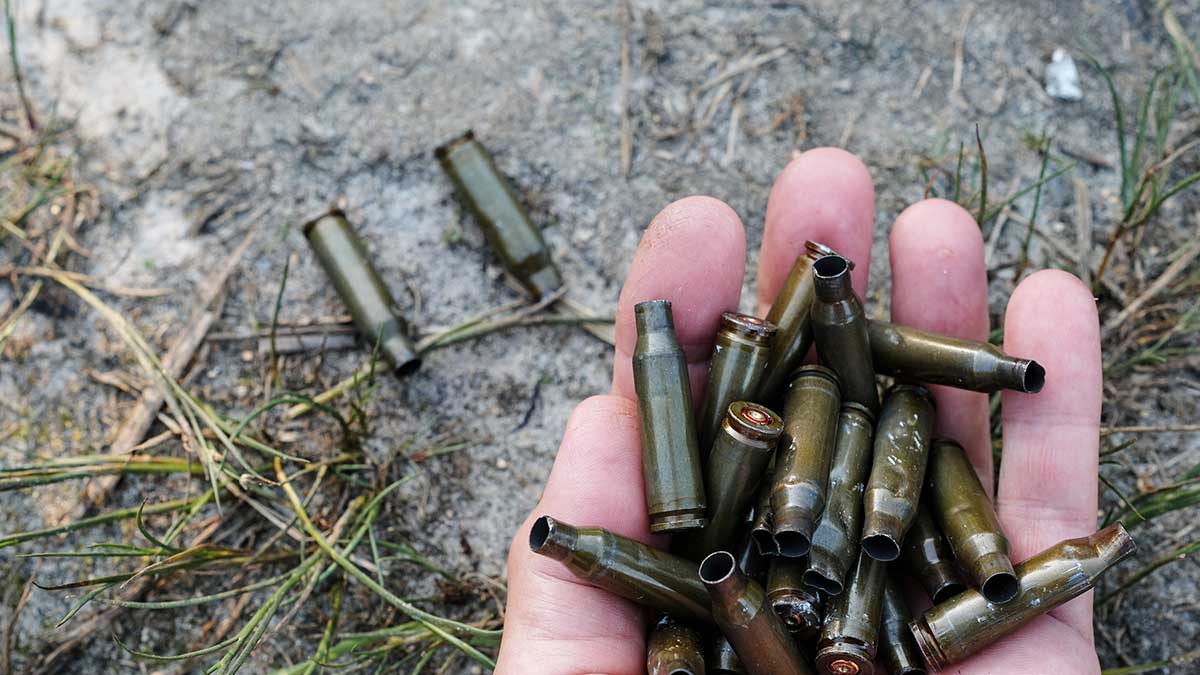What’s your standard routine once you’re done shooting at a gun range? If you’re like most people, you probably empty your firearms, stash them away in their pouches or cases, organize your shooting bag and put away your eye and ear protection, and retrieve your shooting targets.
There’s one more very important thing, however, that too many gun owners, hunters, and target shooters alike all overlook before they leave a range: properly recycling their spent shell casings. Why is this important?
In the United States, it’s estimated that nearly 83 million people own at least one gun, and tens of millions of those people hit the gun range once or more a year.
It’s also been well-documented how shooting ranges produce thousands of tons of pollution each year, and when you consider how many people are going to the range, that shouldn’t be too surprising.
Learning how to dispose of and recycle your ammunition in an environmentally sound way each time after you go shooting is a small and yet insignificant action that you can take as a responsible gun owner to contribute less to this pollution. In this guide, we’ll show you exactly what you need to do and how easy it is.
A Short Guide To Ammunition
First, just to make sure that we’re all on the same page, these are the primary components of ammunition (for handgun and rifle rounds):
- Projectile
- The projectile is the bullet that is propelled by the ignition of gunpowder to travel out of the barrel when the weapon is shot. Most projectiles are made out of lead,
- The projectile is the bullet that is propelled by the ignition of gunpowder to travel out of the barrel when the weapon is shot. Most projectiles are made out of lead,
- Shell Casing
- The shell casing is a metal shell (usually made from brass or aluminum) that houses the gunpowder and the projectile.
- Primer
- The primer is a piece of metal at the end of a shell casing. When struck by the firing pin of a firearm, it ignites the gunpowder in the shell casing.
- The primer is a piece of metal at the end of a shell casing. When struck by the firing pin of a firearm, it ignites the gunpowder in the shell casing.
- Gunpowder
- The gunpowder is the chemicals (usually made out of charcoal, potassium m nitrate, and sulfur) loaded in the casing. When ignited, it produces a lot of gas that expands and pushes the bullet out of the end of the shell casing and down the barrel.
Shotgun shells are different from rifle or handgun rounds. Instead of a casing, shotgun shells have a hull that is usually constructed out of plastic. Shotgun shells also come with a wad, which separates the pellets or the projectile from the gunpowder in the hull. Keep these terms in mind because we’ll be referring back to them below.
Preparing Your Shell Casings For Recycling
Scrap ammo that is not properly disposed of can be a surprisingly stubborn form of pollution. The casings (which are already made out of metal and also come with traces of gunpowder or lead from the projectiles) will eventually break down and release harmful substances into soil and water. Besides posing an obvious risk to the environment, this can also pose risks to human health if those elements find their way into the water and food chains.
Gun ranges produce a lot of this kind of waste. A few years ago, the Saskatoon Police Department in Canada conducted a study to find out just how much lead they were producing each year from their shooting range. They discovered that over the course of three years they had produced over 18,000 pounds of lead from the bullets their officers had fired during practice sessions alone.
Now think about all of the other shooting ranges across the United States and Canada, and you should easily be able to see how fast it all adds up!
The good news is that the only thing we need to do to help prevent this is to recycle spent shell casings each time we go shooting instead of carelessly tossing the casings away. Here’s what you’ll need to do to get your casings ready for recycling:
Sort the Ammunition
The first thing you should do is to sort the aluminum based on its materials:
- Aluminum ammunition
- Brass ammunition
- Shotgun shells
- Lead
It’s important to sort your ammunition like this if you’re going to be handing it over to a metal scrap yard for recycling (more on this in a bit). For example, a scrap yard could pay you for every pound of brass, but they won’t be able to weigh your brass accurately if it’s mixed in with aluminum casings and shotgun shells.
Store the Casings
Now you need to store the shell casings until you are ready to recycle them later. Make sure the casings are stored in a cool and dry location. Ideally, you should also store them in an airtight container so they are kept shielded from moisture.
Clean the Casings
You’ll want to remove as much gunpowder as possible from the casings so they are safer to be recycled. The best way to do this is to gently tap the casing to dislodge any loose powder, and then soak in a container to help any remaining residue to break down. You can also use a brass brush to scrub the casings on the inside and out to get rid of further gunpowder as well.
One of the most important things to remember is that you should never try to recycle live ammunition. Only recycle the spent shell casings and shotgun shells. If you need to dispose of live ammunition or ammunition that failed to fire, take it to a local gun range or police station and they will dispose of it correctly for you.
Disposing of and Recycling Shell Casings
You have three primary options when it comes to recycling your shell casings:
The local Police Station should take your spent shell casings to recycle so long as you have a small amount. You’ll want to give your local station a call or an email to make sure.
Gun Ranges may offer recycling and, if they don’t, ,make a point of speaking to the range master in-person to see if they’ll recycle your spent shell casings.
Scrap Metal Recyclers are often the most convenient and potentially profitable way for you to recycle ammo is simply to drop it off at a scrap metal recycling center, some of which will pay you for dropping off metal scrap.
For example, it’s common for recycling centers to pay between $1 to $2 per pound of brass. By not picking up your brass and recycling it, you’re literally throwing money away!
You might be wondering how the ammo itself is recycled by the recycling center. Basically, the team at the scrap center will verify that the shells can be recycled and will remove as much lead and dirt as they can. Then they’ll use a device that can take the shells and form them down into smaller pieces; these metal pieces will then be sent to a brass mill where they can be melted down and combined with other metallic elements to make other metal materials.
Checklist: Do’s and Don’ts
Keep this checklist of do’s and don’ts to remember to follow when recycling ammo:
- DO take your casings to a police station, gun range, or scrap metal center for recycling
- DO organize the casings into their material types before taking them to be recycled
- DO remove as much gunpowder from the casings as possible before recycling
- DON’T attempt to recycle live ammo or dud rounds
- DON’T bury the casings instead of recycling them (the metal can contaminate the soil, and subsequently the water supply)
- DON’t throw the shell casings away in the trash or trash compactor (a compactor can cause any unfired rounds to fire)
Make sure you follow the above do’s and don’ts, and you’ll be good to go!
At the end of your next range session, give your spent shell casings a second thought instead of simply tossing them away in a bin or leaving them on the ground. Recycling ammunition is a simple and yet meaningful way to help reduce harmful pollutants from getting into our soil and water. That’s why you should take action to recycle your ammunition like we’ve discussed here today, and be sure to encourage other people you go shooting with to do the same!
Source link
Earth911 earth911.com


